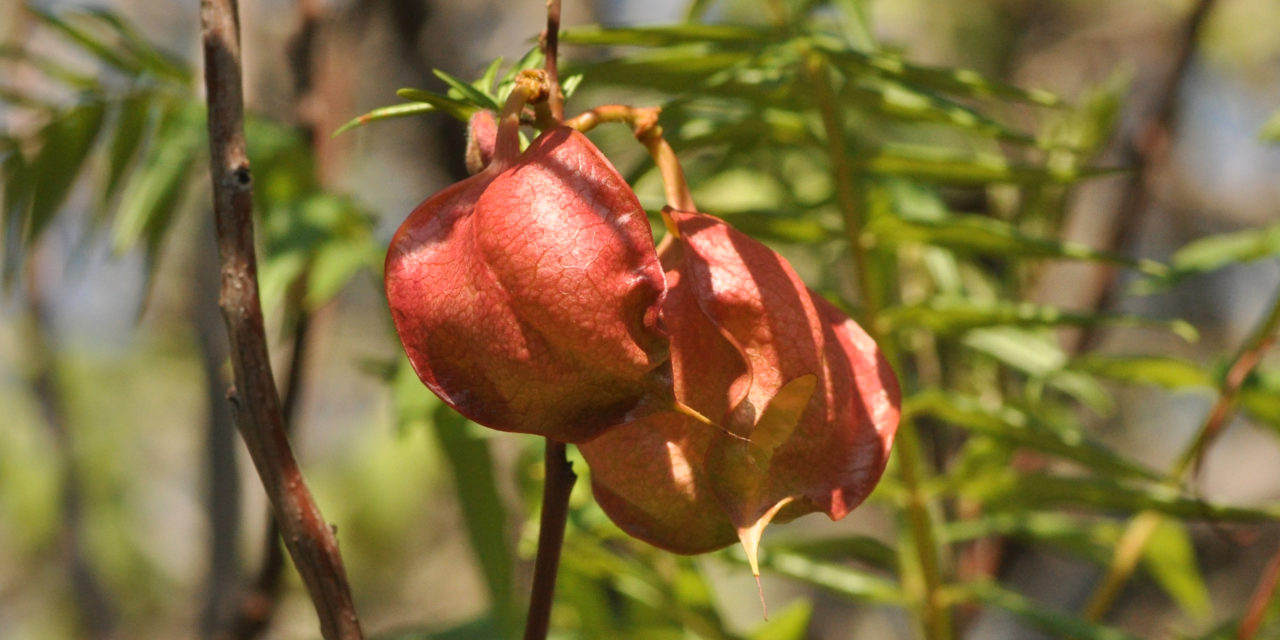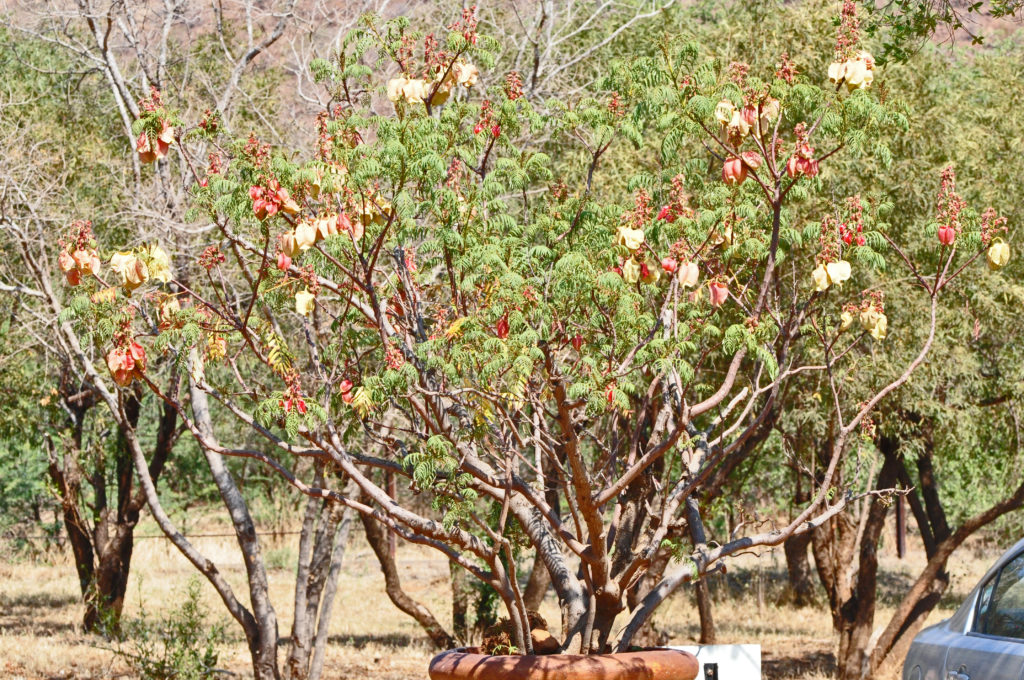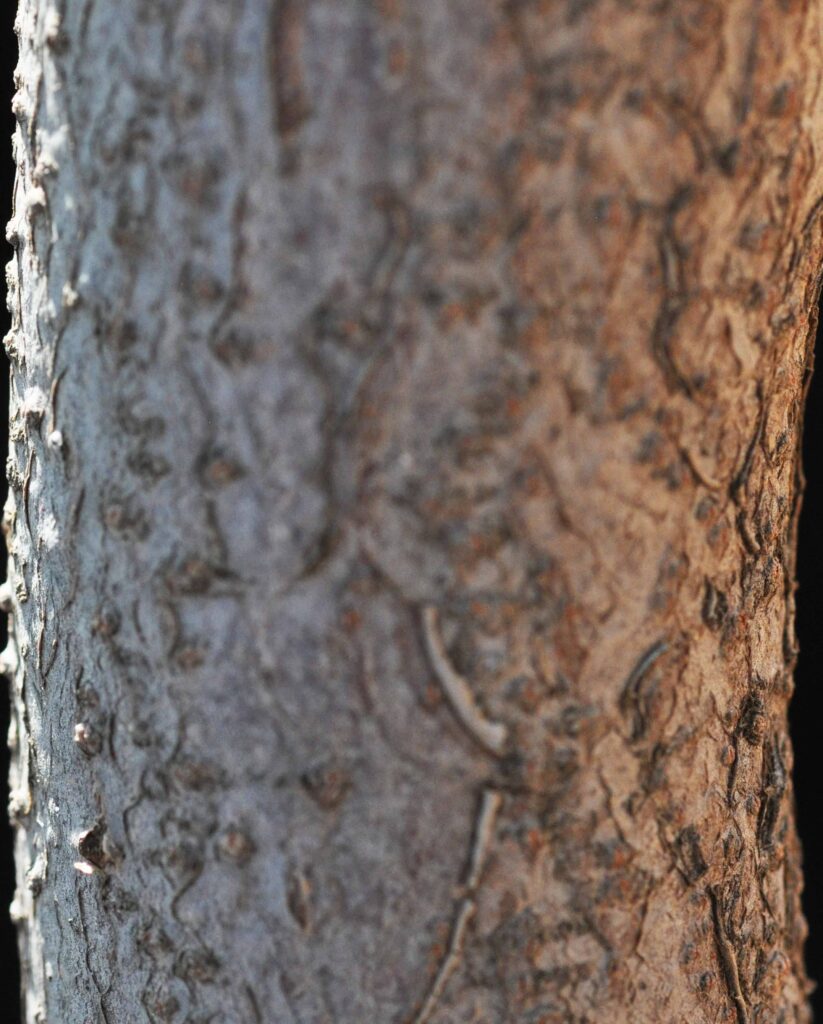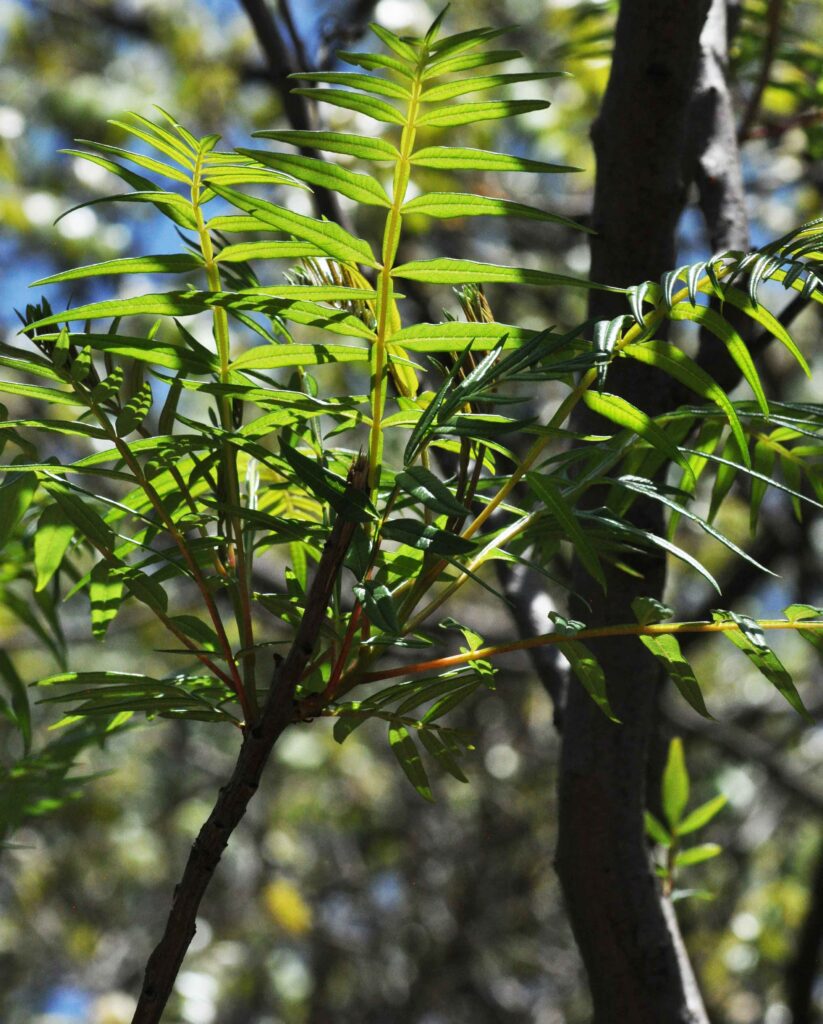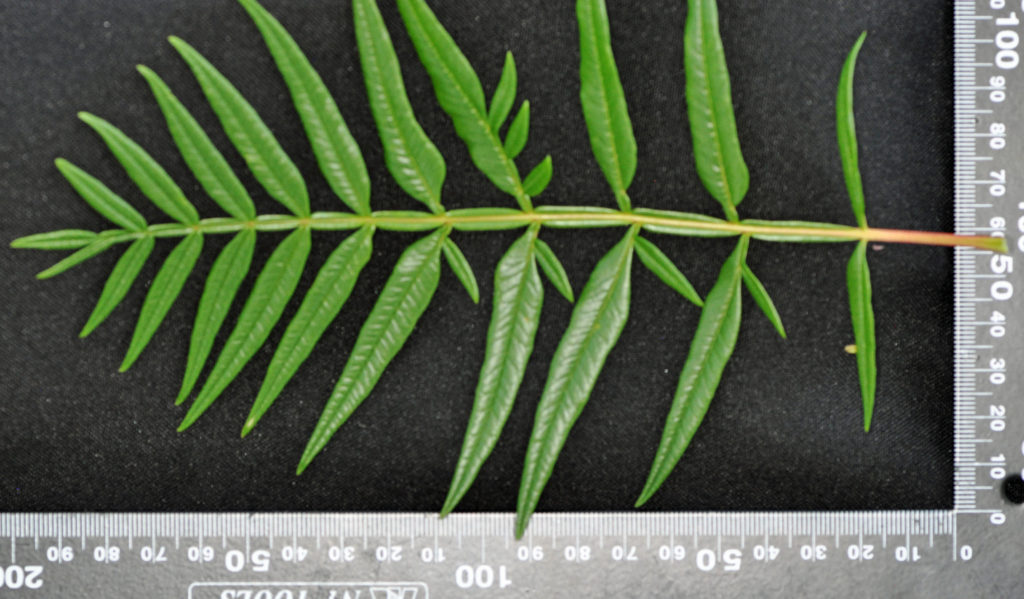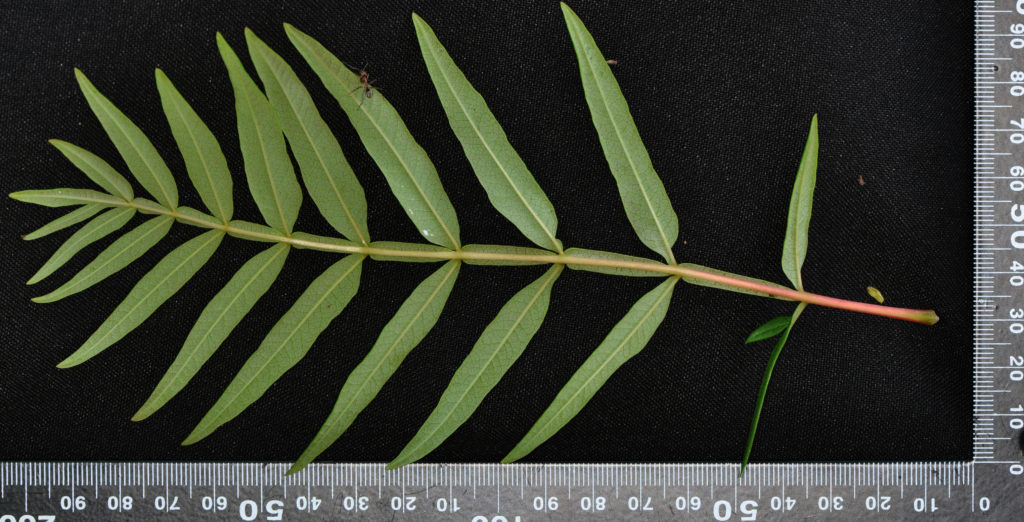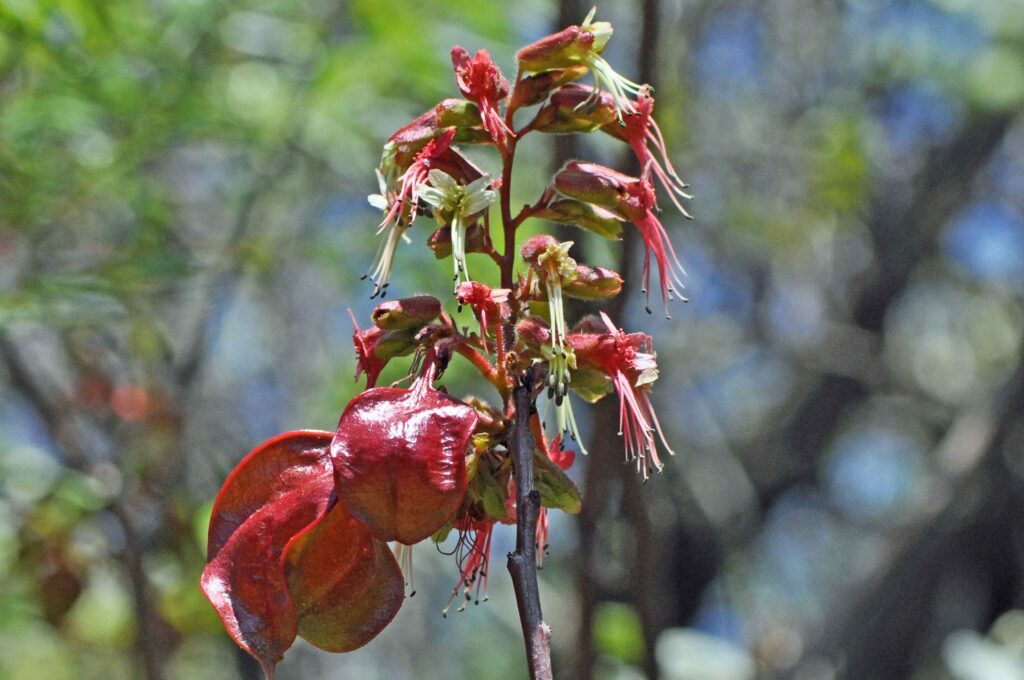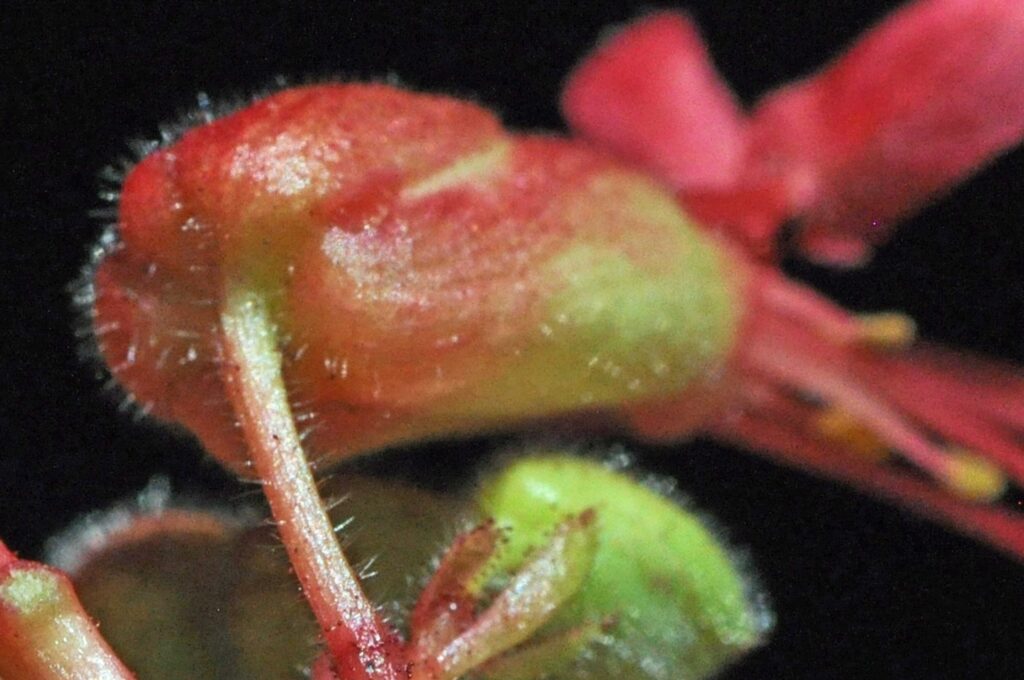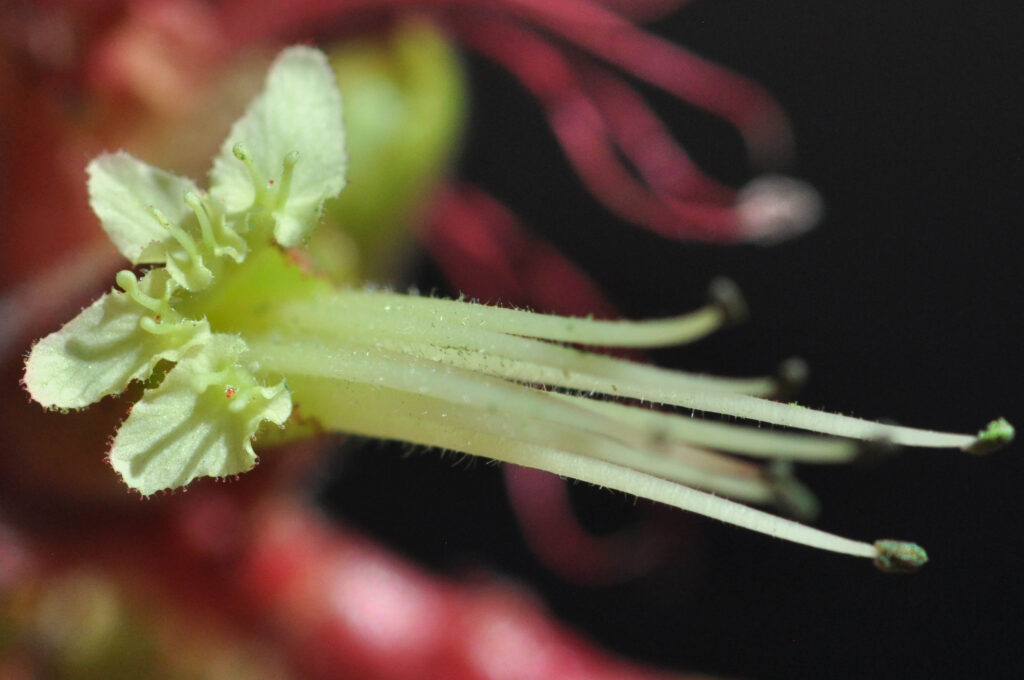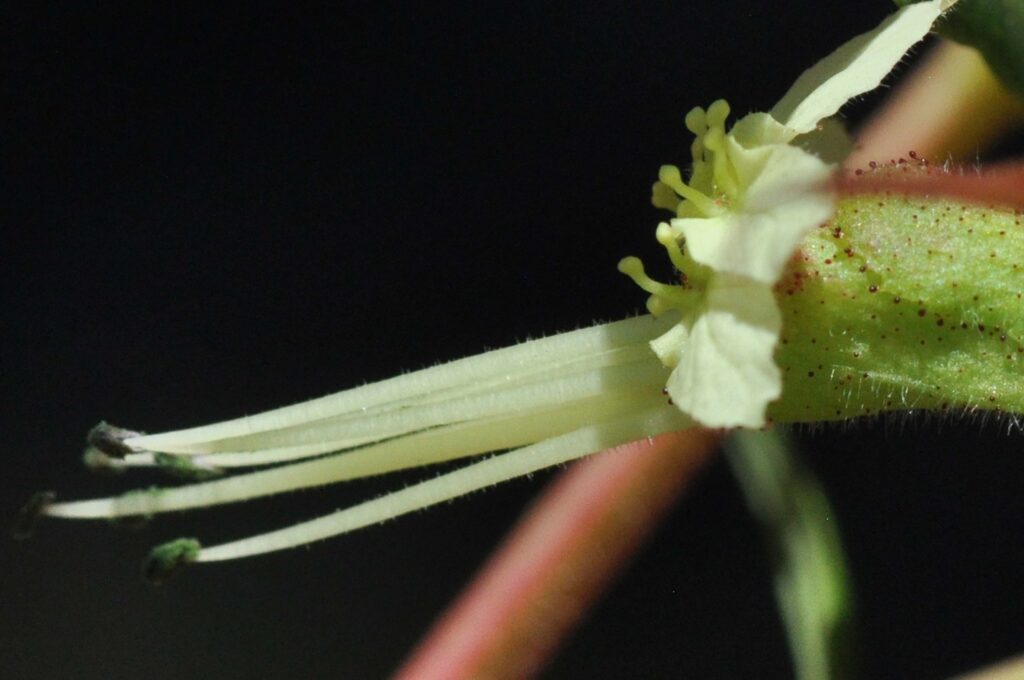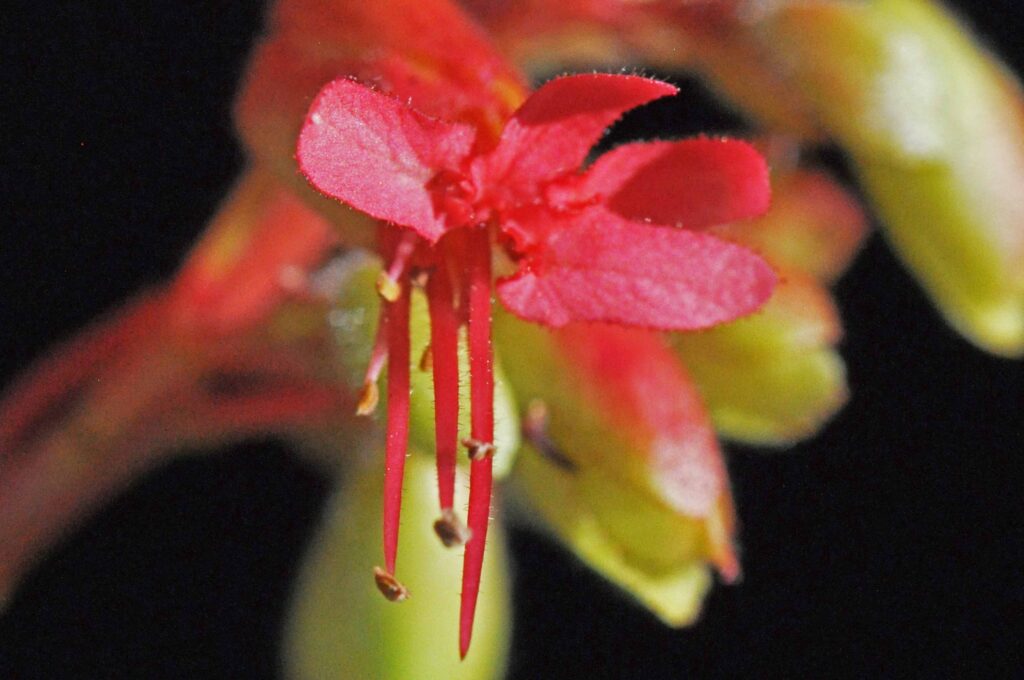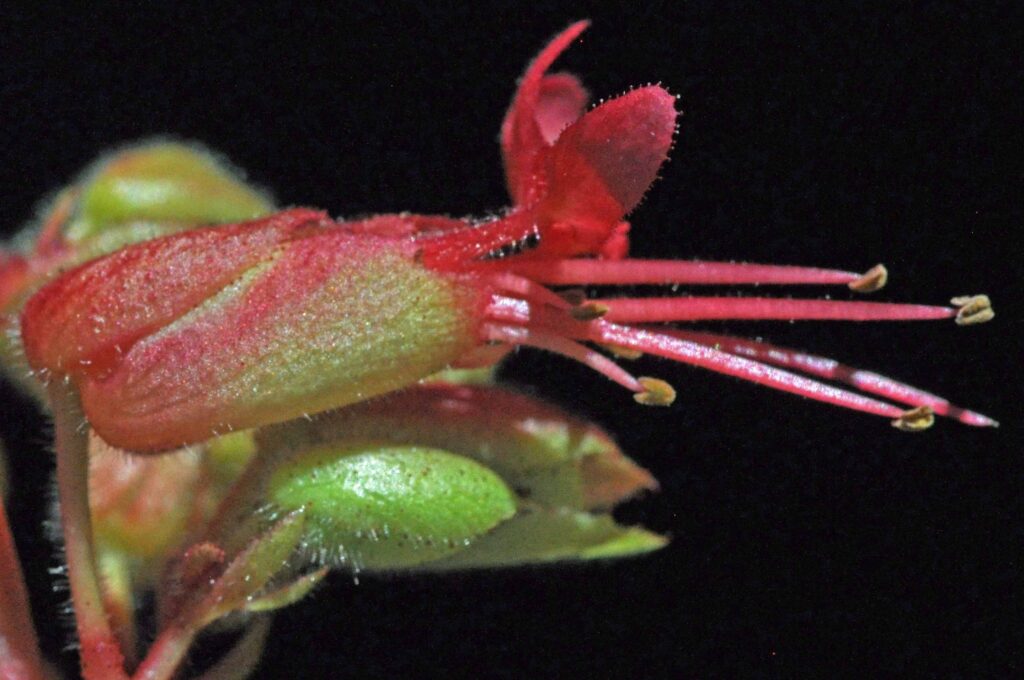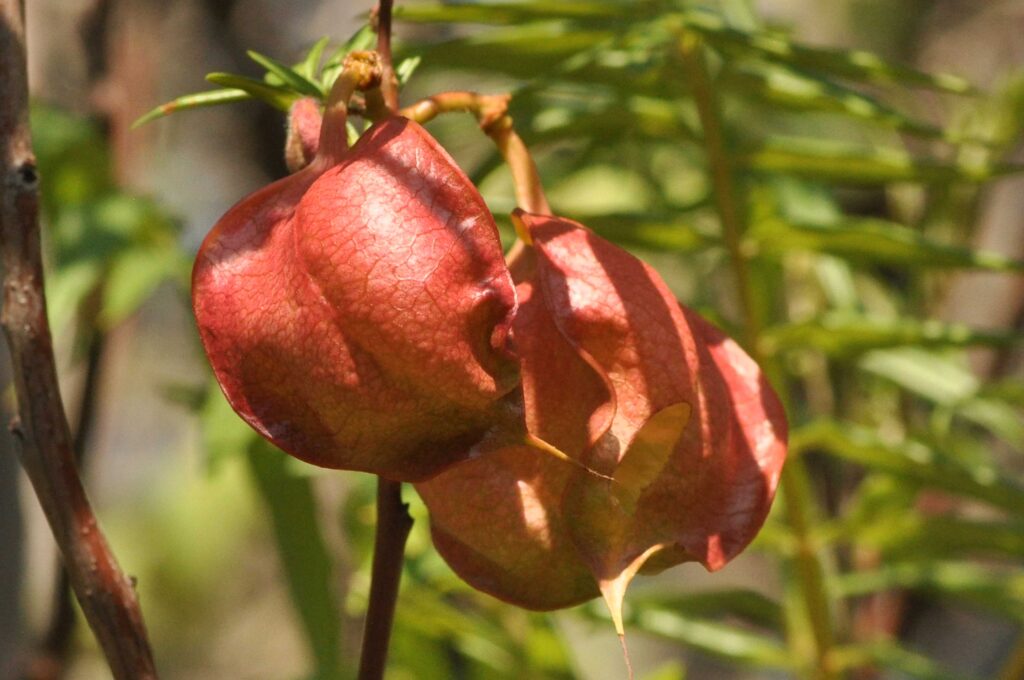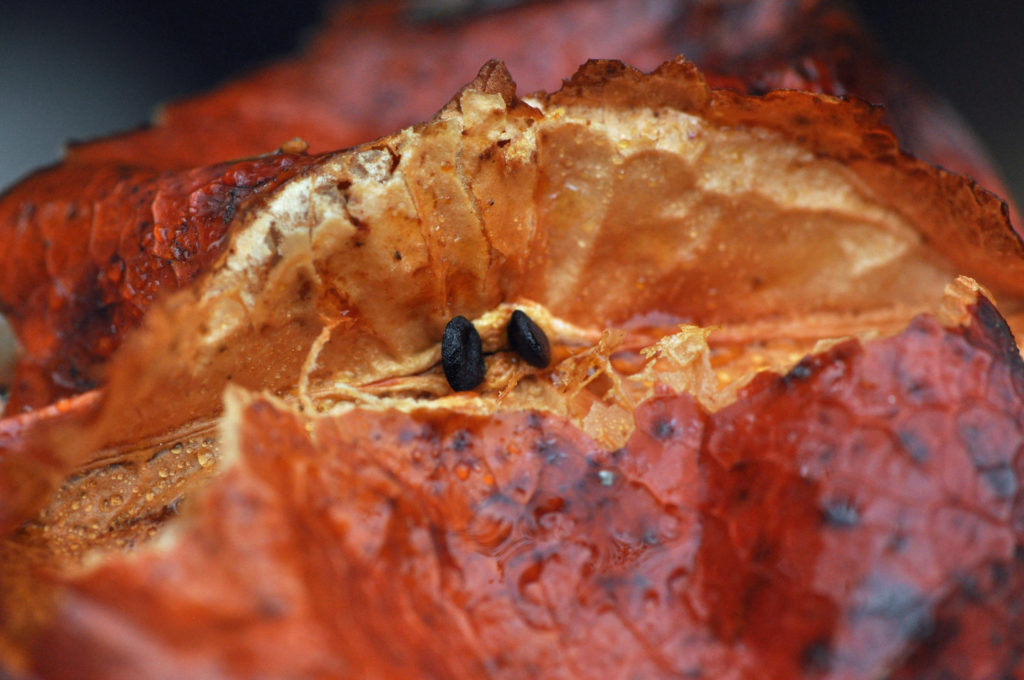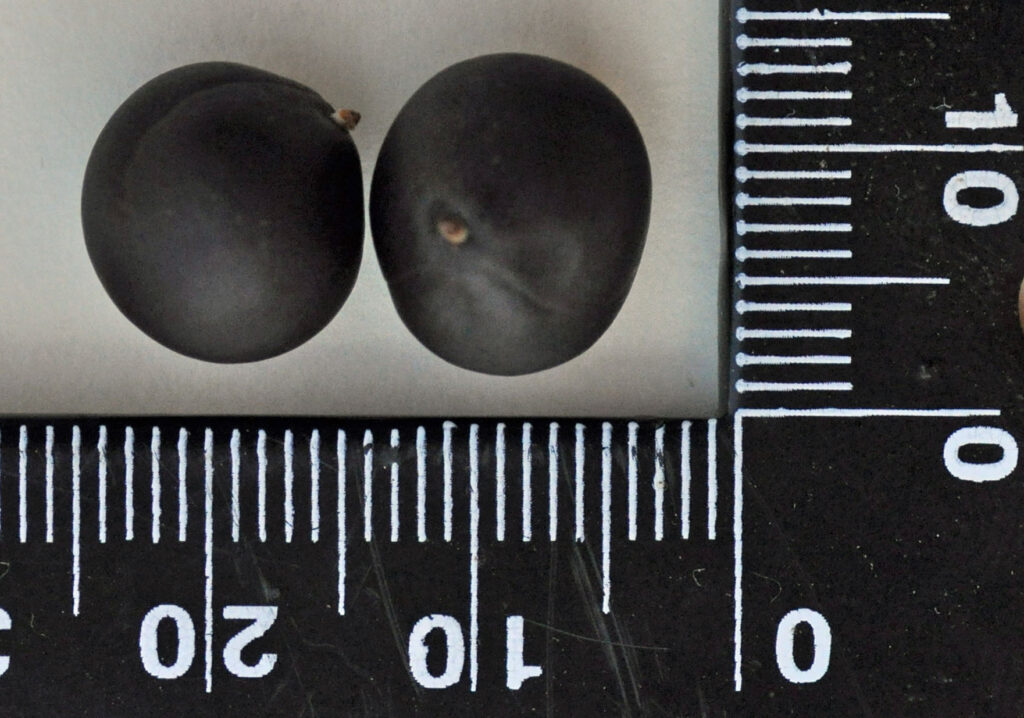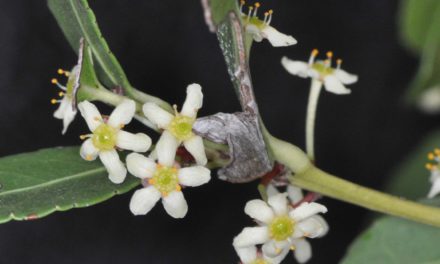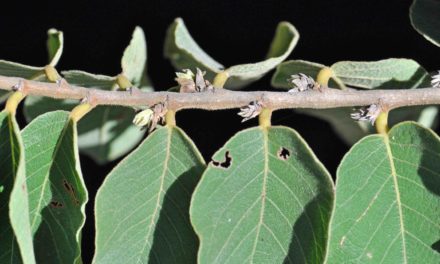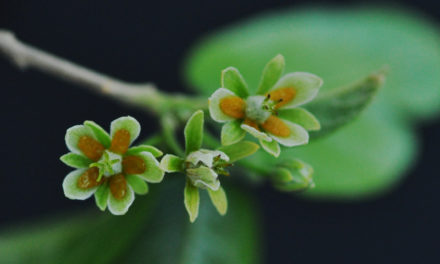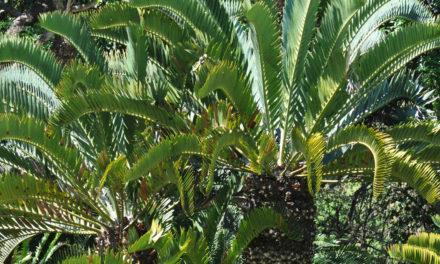General Info – summary
This deciduous Tree is up to 5m high & trunk up to 20cm wide. It may be a multi-stemmed shrub. The imparipinnate Leaves have leaflets attached to a green winged rachis. Leaflets are clearly separated along the midrib and may have lobe-like extensions. Red/green bisexual Flowers are in panicles. 8 red stamens surround the superior, stalked ovary. The 3-angled Fruit is an inflated capsule with roundish black seeds.
Description
Erythrophysa transvaalensis
SA Tree No.436.2.
Common names: (Afr) Bosveldrooiklapperbos, Rooiklapperboom, Rooiklapperbos, Transvaalse rooiklapperbos. (Eng) Bushveld Red Balloon, Red Balloon, Transvaal red balloon, Wild Jacaranda. (Setswana) Mofalatsane.
Family: Sapindaceae. (Soapberry and Litchi family). This family has 135 genera and about 1 850 species which occur in temperate and tropical areas. Plants may contain latex. The opposite or alternate, usually compound Leaves may lack stipules (leaf stalks) and may have a swollen base. The small, usually unisexual, Flowers may be regular or irregular and develop in racemes or panicles. The Calyx has 4-5 lobes and, when present, the Corolla has 3-5 petals. There are between 5 and 24 Stamens, which have free Filaments and the Anthers have 2 pollen sacs. The superior Ovary may have up to 3 styles, each ending in a simple stigma. There are 27 species in 14 genera in southern Africa. Local genera with trees on this website include Allophylus, Atalaya, Dodonaea, Erythrophysa, Filicium, Hippobromus, Pappea, Smelophyllum and Stadmannia. 2023.05.30.
Name derivation: Erythrophysa – red-bag: referring to the red bladder-like fruits. transvaalensis from the old Transvaal province. Today the plant is found in 2 provinces of the old Transvaal – namely North West and Limpopo. There are 2 species of this genus in southern Africa. The other is E. alata. An additional species is found in Ethiopia and there are 2 species in Madagascar. The engineer (V.K. Hands) in charge of building the Bospoort Dam was the first to collect this plant. He noted that the local women used the seeds as beads and sent a specimen to the Botanical Research Institute in 1933. The discovery created a lot of excitement in the botanical community. What is thought to be its nearest relative, occurs in Northern China. This is now one of the Protected Tree Species in the South Africa.
Conservation Status: L. C. (Least Concern). Assessed: 2016. (A.E. van Wyk, P.J.D. Winter, N. Hahn and L. von Staden). This plant is classified as vulnerable in Zimbabwe. In SA the threats are minimal.
Tree
The small sparsely branched Tree with low down branching either is up to 5m high or may be a multi-stemmed shrub (photo 658). The Stem is up to 20cm wide, and branches are thin (photo 703) and brittle. Branching occurs near the base. The reasonably smooth, grey to reddish-brown Bark (photo 703) is shiny.
- 658. 2018/11/16 Pilanesberg NP. Photo: David Becking.
- 703. 2018/11/19. Pilanesberg NBG. Photo: David Becking.
- 719. 2017/10/31. Pretoria NBG. Photo: David Becking.
Leaves
On this partly deciduous plant, the distinctively graceful Leaves are imparipinnate (pinnately compound leaf ending in a single leaflet). The distance between leaflet pairs decreases towards the leaf apex. Leaves only occur on new growth and are thus concentrated towards the ends of branches. Leaves have a distinctly green Winged Rachis (the main axis bearing leaflets in this case photos 725 and 726). In addition to the single terminal Leaflet there are up to 12 pairs of leaflets. Leaflets are opposite or nearly so and clearly separated along the rachis. They are slightly asymmetric (not equal on both sides) especially towards the base. On the upper surface, the leaflets are medium green and shiny (photo 726). Here the Midrib (the main rib of a leaf or leaf-like part is a continuation of the petiole) and lateral veins are sunken. On the lower surface, the leaflets are relatively dull green, and the midrib protrudes (photo 725). Towards the base, some leaflets may have unusual lobe-like extensions (photo 726). Individual leaflets are narrowly lanceolate (photo 725 and up to 8 x 1cm. The Apex and Base taper but the apex tapers more narrowly. The reddish Petiole (leaf stalk) is up to 2,6cm long (photo 725) and is usually not winged. Petiolules (leaflet stalks) and Stipules (basal appendages of petioles) are absent.
- 726. 2017/10/31. Pretoria NBG. Photo: David Becking.
- 725. 2017/10/31. Pretoria NBG. Photo: David Becking.
Flowers
The red or green and usually bisexual Flowers are up to 1,5 x 1cm. If unisexual, they may be borne on the same or different trees. They develop in erect Panicles (indeterminate, branched inflorescence with stalked flowers – photo 718). Flowers may appear before or with the new leaves. The reddish Calyx (photo 798) has 4 fused hairy Sepals that are bell-shaped at the base (photo 799). Here the hairy Pedicel (stalk of a single flower) is visible. The attached lobes are elliptic. The Corolla has 4 clawed or crested parts and is initially green (photo 251) Petals which are suffused with red or turn completely red (photo 796). The fifth petal is deficient and here a fleshy gland develops. The 8 straight, initially green Stamens of different lengths (photo 251) arise in a bundle sheath below the fleshy gland which is to the one side of the Disc (a more or less fleshy or elevated development of the receptacle). The straight, close together, hairy Filaments are free and exserted (sticking out; projecting beyond). These filaments are nearly circular in cross section and change from light green to red as they mature (photos 721 and 796). The terminal Anthers become brown and are versatile (hung or attached near the middle, and usually moving freely – photo 798). Anthers have 2 Thecae (pollen sacs – microsporangia of an anther. They produce microspores (pollen grains in seed plants). The stalked superior Ovary is trilocular and has 2 Ovules in each locule (photo 655 – under Fruit). From the ovary, a single Style emerges and this ends with a simple Stigma (the part of the pistil that receives the pollen). (Sep-Oct).
- 718. 2017/10/31. Pretoria NBG. Photo: David Becking.
- 799 2018.02.12 Pretoria NBG. Photo: David Becking.
- 251. 2019/10/08 Pretoria NBG. Photo: David Becking.
- 721. 2017/10/31. Pretoria NBG. Photo: David Becking.
- 796. 2018/02/12. Pretoria NBG. Photo: David Becking.
- 798. 2018/02/12. Pretoria NBG. Photo: David Becking.
Fruit
The attention catching, attractive 3-angled and 3 locular, inflated bladder-like Fruit (photo 932) is a large – up to 8 x 5cm Capsule (a dry fruit resulting from the maturing of a compound ovary which usually opens at maturity by one or more lines of dehiscence). This initially green capsule becomes an impressive red at maturity or may retain some green. Usually 3 purple-black, round Seeds are finally produced that have a diameter of up to 1,5cm (photo 451). The slightly flattened seeds lack endosperm (the starch and oil-containing tissue of many seeds; often referred to as the albumen). The released bladder-like fruit is moved by the wind and rain. This disperses the now fertile seeds. The attractive fruit may remain on the tree well past summer.
- 932. 2017/11/14. Pretoria NBG. Photo: David Becking.toria NBG
- 655. 2018/01/30. Pretoria NBG. Photo: David Becking.
- 451. 2019/09/03. Pretoria NBG. Photo: David Becking.
Distribution & Ecology
This plant is Endemic in southern Africa. (Endemic – restricted to a particular geographic location). In South Africa, the plant is located in Western Gauteng, Limpopo and North West e.g. near the Bospoort Dam, which lies near to Rustenburg. Here the water is reportedly not fit for human consumption. It was from here that this tree was first described in the 1930’s. Another location in the North West is the Pilanesberg National Park. In Limpopo Province, it has been found in dolomitic areas (sedimentary carbonate rock containing calcium and magnesium) near the 133m long Strydom tunnel (between Hoedspruit and Graskop – both just west of the Kruger National Park. The plant may be associated with outcrops of red syenite (a coarse-grained intrusive igneous rock similar to quartzite but usually lacking quartz). Beyond South African borders, it has now been found in Zimbabwe e.g., south-west of Bulawayo and in south-eastern Botswana. The plant is fire resistant and is found on rocky hillsides, dry areas and Koppies (Koppie/koppje is a small hill arising from the African veld). These flowering plants attract sunbirds.
Ethnobotany
This tree would be an asset to a garden in a low frost area. Propagation is from cuttings or from seeds and the plant grows in both shade and full sun. Plant Seeds soon after they are collected. Local people use the hard seeds as beads.
References
Coates Palgrave, M. 2002. Keith Coates Palgrave Trees of Southern Africa, edn 3. Struik, Cape Town.
Lawrence, G. H. M, 1951. Taxonomy of Vascular Plants, The Macmillan Company, New York. Tenth Printing 1965.
Palmer, E. & Pitman, N. 1972. Trees of southern Africa, Balkema, Amsterdam, Cape Town.
van Wyk, A.E., Winter, P.J.D., Hahn, N. & von Staden, L. 2016. Erythrophysa transvaalensis I.Verd. National Assessment: Red List of South African Plants version 2020.1. Accessed on 2023/05/12
van Wyk, B. & van Wyk, P. 1997 Field guide to Trees of Southern Africa, Struik, Cape Town.
Archer, R H. for help with the plant ID.
https://en.wikipedia.org/wiki/Bospoort_Dam
http://pza.sanbi.org/erythrophysa-transvaalensis
http://www.zimbabweflora.co.zw/speciesdata/species.php?species_id=137490&ishow_id=1
https://jbg.gardenexplorer.org/taxon-1248.aspx
http://posa.sanbi.org/flora/browse.php?src=SP
http://flora.huh.harvard.edu/china/mss/volume12/Sapindaceae.pdf

